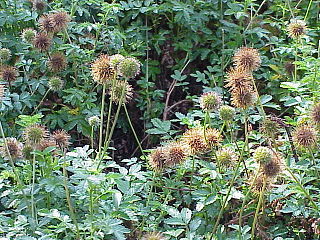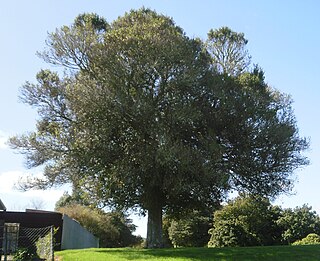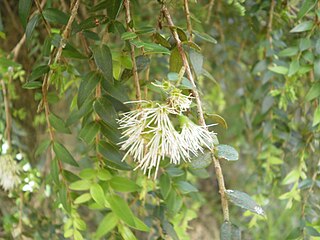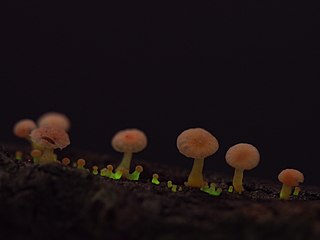
Kōwhai are small woody legume trees within the genus Sophora, in the family Fabaceae, that are native to New Zealand. There are eight species, with Sophora microphylla and S. tetraptera being the most recognised as large trees. Their natural habitat is beside streams and on the edges of forest, in lowland or mountain open areas. Kōwhai trees grow throughout the country and are a common feature in New Zealand gardens. Outside of New Zealand, kōwhai tend to be restricted to mild temperate maritime climates.

Acaena is a genus of about 60 species of mainly evergreen, creeping herbaceous perennial plants and subshrubs in the family Rosaceae, native mainly to the Southern Hemisphere, notably New Zealand, Australia and South America, but with a few species extending into the Northern Hemisphere, north to Hawaii and California.

Coriaria is the sole genus in the family Coriariaceae, which was described by Linnaeus in 1753. It includes 14 species of small trees, shrubs and subshrubs, with a widespread but disjunct distribution across warm temperate regions of the world, occurring as far apart as the Mediterranean region, southern and eastern Asia, New Zealand, the Pacific Ocean islands, and Central and South America.

Pimelea, commonly known as rice flowers, is a genus of plants belonging to the family Thymelaeaceae. There are about 150 species, including 110 in Australia and 36 in New Zealand.

Carmichaelia is a genus of 24 plant species belonging to Fabaceae, the legume family. All but one species are native to New Zealand; the exception, Carmichaelia exsul, is native to Lord Howe Island and presumably dispersed there from New Zealand.

Clianthus, commonly known as kakabeak, is a genus of flowering plants in the legume family Fabaceae, comprising two species of shrubs endemic to the North Island of New Zealand. They have striking clusters of red flowers which resemble the beak of the kākā, a New Zealand parrot. The plants are also known as parrot's beak, parrot's bill and lobster claw – all references to the distinctive flowers. There is also a variety with white to creamy coloured flowers called: "Albus," and a variety with rosy pink flowers called: "Roseus."

Cranfillia fluviatilis, synonym Blechnum fluviatile, is a fern known in the Māori language as kiwikiwi. A herbaceous plant, C. fluviatilis is a "hard fern" of the genus Cranfillia in the family Blechnaceae. It was identified by Patrick Brownsey in 1979. Other common names are star fern, creek fern, kawakawa and kiwakiwa.

Clianthus maximus, commonly known as kaka beak, is a woody legume shrub native to New Zealand's North Island. It is one of two species of Clianthus and both have striking clusters of red flowers which resemble the beak of the kaka, a New Zealand parrot.

Astelia is a genus of flowering plants in the recently named family Asteliaceae. They are rhizomatous tufted perennials native to various islands in the Pacific, Indian, and South Atlantic Oceans, as well as to Australia and to the southernmost tip of South America. A significant number of the known species are endemic to New Zealand. The species generally grow in forests, swamps and amongst low alpine vegetation; occasionally they are epiphytic.

Dicksonia fibrosa, the golden tree fern, whekī-ponga, wheki-kōnga, or kurīpākā is a species of medium-sized tree fern native to New Zealand.

Paratrophis microphylla, commonly known as the small-leaved milk tree, is a species of plant in the family Moraceae that is endemic to New Zealand.

Parsonsia heterophylla, commonly called New Zealand jasmine or kaihua, is a climbing plant endemic to New Zealand. It was first described by Alan Cunningham in 1839.

Metrosideros colensoi, the climbing rata or Colenso's rātā, is a forest liane or vine that is endemic to New Zealand. It is one of a number of New Zealand Metrosideros species which live out their lives as vines, unlike the northern rata (M.robusta), which generally begins as a hemi-epiphyte before growing into a huge tree. It grows to around 6 metres in height and bears clusters of pink or white flowers. It is unusual amongst New Zealand's metrosideros species in that its branches display a weeping habit, forming a 'hanging curtain' appearance. This behaviour is uncommon in New Zealand native plants. The name commemorates William Colenso, an early Cornish Christian missionary who was one of the great characters of New Zealand botany.

Sophora chathamica, the coastal kōwhai, sometimes known as Chatham Island kōwhai, is one of 8 species of native sophora or kōwhai in New Zealand and grows naturally in the north-west of the North Island in New Zealand, as far south as the Tongaporutu River in north Taranaki, and as far north as Te Paki. It can also be found growing near Wellington and the Chatham Islands, although these later plantings are thought to be a result of Māori plantings in the late 18th century and early 19th century. Prior to 2001, it was included as variant of Sophora microphylla, therefore references to either Sophora microphylla var. chathamica or Sophora microphylla subsp. microphylla var. chathamica are considered references to coastal kowhai.

Metrosideros albiflora, also known as large white rātā, Northland white rātā, akatea or simply white rātā, is a forest liane or vine endemic to New Zealand. It is one of three white flowering rātā vines. The name "albiflora" indeed literally means white flowered. Despite the similar names, large white rātā is distinguished by its much larger leaves and flowers. Its flowers are amongst the largest of any rātā, similar in size to both scarlet rātā and pōhutukawa. It occurs almost exclusively in Kauri forests from the northern Kaimai Ranges to Te Paki at the top of the North Island.
Pimelea traversii is a species of shrub in the family Thymelaeaceae. It is native to New Zealand. The specific epithet traversii is in honor of naturalist Henry H. Travers (1844-1928), son of William Thomas Locke Travers.

Carystoterpa fingens, commonly known as the variegated spittlebug, is a spittlebug of the family Aphrophoridae. It is endemic to New Zealand.

Acaena microphylla, the bidibid or piripiri, and outside New Zealand, New Zealand-bur, is a small herbaceous, prostrate perennial flowering plant in the rose family Rosaceae, native to both the North and South Islands of New Zealand. There are two varieties:

Dracophyllum subulatum, commonly known as monoao, is a species of tree or shrub in the heath family Ericaceae. It is endemic to the central North Island of New Zealand.

Mycena roseoflava is a species of agaric mushroom in the family Mycenaceae. It was first discovered in 1964 by New Zealand mycologist Greta Stevenson. It is a wood-inhabiting mushroom native to New Zealand.



















